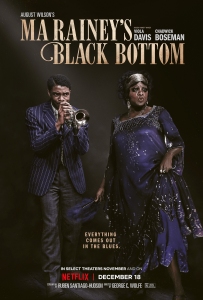Premise: Chicago, 1927. A recording session. Tensions rise between Ma Rainey, her ambitious horn player and the white management determined to control the uncontrollable “Mother of the Blues”. Based on Pulitzer Prize winner August Wilson’s play.
Adapted from August Wilson’s play of the same name, Ma Rainey’s Black Bottom has the energy of watching a stage production that’s morphed effortlessly onto film. This isn’t an easy accomplishment by any stretch and the fact that it’s pulled off so brilliantly here is a testament to George C Wolfe’s direction and overall vision for the film. The way the camera swings through sharp and incisive dialogue spoken between multiple characters in a green room gives the film a fluidity that can only be matched by seeing a stage performance. The camera commandeers the drama and makes it feel like the film itself is a ride through the interpersonal spats and ambitions of the characters without letting up. In terms of pacing, Ma Rainey’s Black Bottom is spectacular.
Despite taking place in just a few locations, Ma Rainey does not feel the least bit contained. Through stunning cinematography, costuming, and set design, the film creates a vibrant picture of 1920’s Chicago that really sticks in your memory. With a few choice exterior scenes to help set the tone and atmosphere, the film never feels out of step with the world it has created for us. With the band rehearsing in a cold, dimly lit room and Ma recording in a state of the art (to an extent) space, the hierarchy that exists among the talent is never in question.
As such, Chadwick Boseman (playing Levee, an ambitious band member) and Viola Davis (who plays the titular Ma Rainey) are equally brilliant in their performances. The film creates a vivid dichotomy between Ma and Levee, though they don’t interact much together. Both are artists who are working at different levels of the entertainment industry. While Ma has some clout over how the white producers and managers use her talents, Levee is an unknown musician driven by his hunger and ambition. Ma makes demands and asserts her control over her art in scenes where Viola Davis absolutely explodes on screen. Whereas Levee must resort to schmoozing the producers and making concessions for his own art to be heard.
The way the film contrasts Ma and Levee’s paths toward fame and recognition creates a panoramic view of the industry’s attempts to erase or control the African American voice in art. The film further develops this view by delving into the characters’ more personal history with white America. Boseman delivers an astonishingly powerful monologue early in the film that puts you through the emotional wringer. The way this monologue is called back later in the film through another scene showcasing Boseman’s prowess provides a powerful bookend to the film’s drama and overarching commentary.
Chadwick Boseman’s legacy is one filled with roles that explored the history and inspired the future of the African American community. To that end, his work in Ma Rainey’s Black Bottom is a beautiful swan song for a career and life that was taken far too soon. Boseman’s powerhouse performance as Levee in Ma Rainey’s Black Bottom underscores what a tremendous loss his passing was to the film community. It’s easily one of the best performances of the year and potentially the best performance of Boseman’s entire career, tragically short as it was. But above all else, Ma Rainey’s Black Bottom is a stunning film exploring racial injustice and inequality through the story of a band recording a record in 1927 Chicago.
Ma Rainey’s Black Bottom premieres on Netflix on December 18th.
 About the Writer: Matt Hurt is the creator of ObsessiveViewer.com. He also created, hosts, and produces The Obsessive Viewer, Anthology, and Tower Junkies podcasts. He is a member of the Indiana Film Journalists Association and lives in Indianapolis with his cat Pizza Roll.
About the Writer: Matt Hurt is the creator of ObsessiveViewer.com. He also created, hosts, and produces The Obsessive Viewer, Anthology, and Tower Junkies podcasts. He is a member of the Indiana Film Journalists Association and lives in Indianapolis with his cat Pizza Roll.



 About the Writer: Matt Hurt is the creator of ObsessiveViewer.com. He also created, hosts, and produces
About the Writer: Matt Hurt is the creator of ObsessiveViewer.com. He also created, hosts, and produces 